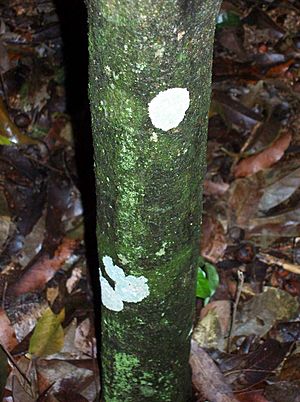Ochrosia moorei facts for kids
The southern ochrosia (scientific name: Ochrosia moorei) is a special plant that grows in the rainforests of eastern Australia. It's a small tree or shrub, and sadly, it's currently in danger of disappearing forever. This means it's an endangered plant, and scientists are working to protect it.
Quick facts for kids Ochrosia moorei |
|
|---|---|
 |
|
| Conservation status | |
| Scientific classification | |
| Genus: |
Ochrosia
|
| Species: |
moorei
|
This plant has a special rating called 2ECi from a group called ROTAP. This rating helps show how rare and threatened it is.
The southern ochrosia lives in warm, wet rainforests. You can find it in the northeast part of New South Wales and the southeast part of Queensland. It grows in special forest areas like Booyong Flora Reserve and Andrew Johnston Big Scrub Nature Reserve. Its natural home stretches from the Richmond River in New South Wales up to Currumbin Creek, which is just across the state border.
The name Ochrosia comes from a Greek word meaning "yellow." This is because some plants in this group have yellow wood or flowers. The plant's full name, Ochrosia moorei, honors a famous botanist named Charles Moore. He was a plant expert who studied many Australian plants.
What Does It Look Like?
The southern ochrosia can be a small tree or a shrub. It can grow up to 11 meters (about 36 feet) tall. Its main stem, called a trunk, can be up to 25 centimeters (about 10 inches) wide. Often, one plant will have several stems growing from its base.
The bark on the trunk is usually dark brown or black. It has many small cracks and bumps that are a lighter color. The smaller branches are also dark brown or purplish-black. Towards their tips, they become more green.
Leaves
The leaves of the southern ochrosia grow in pairs, opposite each other on the stem. Sometimes, they even grow in groups of three. Each leaf is quite long, usually 6 to 18 centimeters (about 2.4 to 7 inches) in length. They are also fairly narrow, about 1.8 to 4 centimeters (about 0.7 to 1.6 inches) wide.
The leaves get narrower where they connect to the branch. If you look closely, you'll see more than 40 small veins branching off the main vein. These veins join the main one at almost a right angle. At the edge of the leaf, these smaller veins connect to form a special vein that goes all the way around the leaf. You can see these veins clearly on both sides of the leaf. The main vein is raised on the underside of the leaf but sinks in on the top. The leaf stalk, which connects the leaf to the branch, is about 5 to 15 millimeters long. If you break a leaf, a white, milky liquid will come out.
Flowers and Fruit
The southern ochrosia produces pretty white flowers. These flowers grow in clusters called cymes at the ends of the branches. You can usually see these flowers blooming from December to February.
About a year after the flowers appear, bright red fruits begin to ripen. These fruits are a type of drupe, which means they have a fleshy outside and a hard pit inside. They are oblong (oval-shaped) and can be 4 to 8 centimeters (about 1.6 to 3.1 inches) long. Inside the fruit, there's a hard, woody center. This center has small spaces on each side where the seeds are held. The seeds themselves are about 10 to 14 millimeters long, 5 to 7 millimeters wide, and only about 1 millimeter deep.


